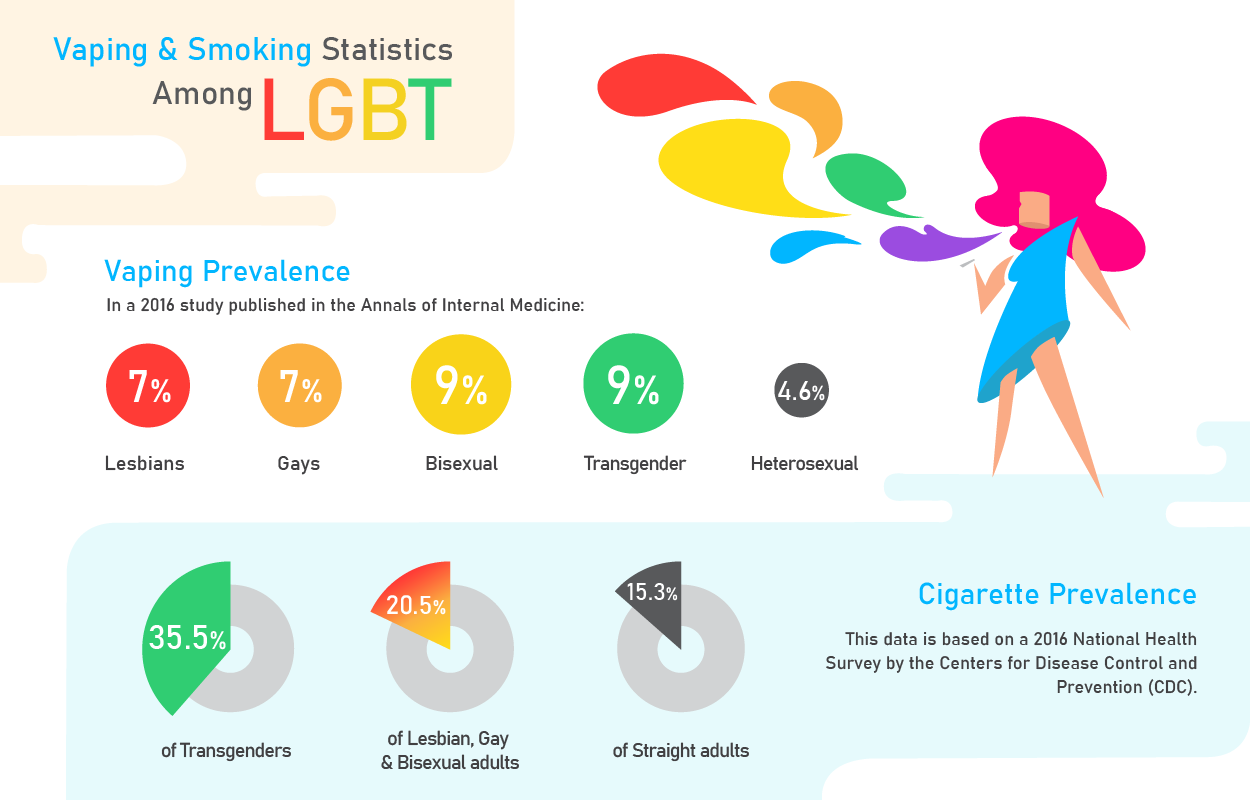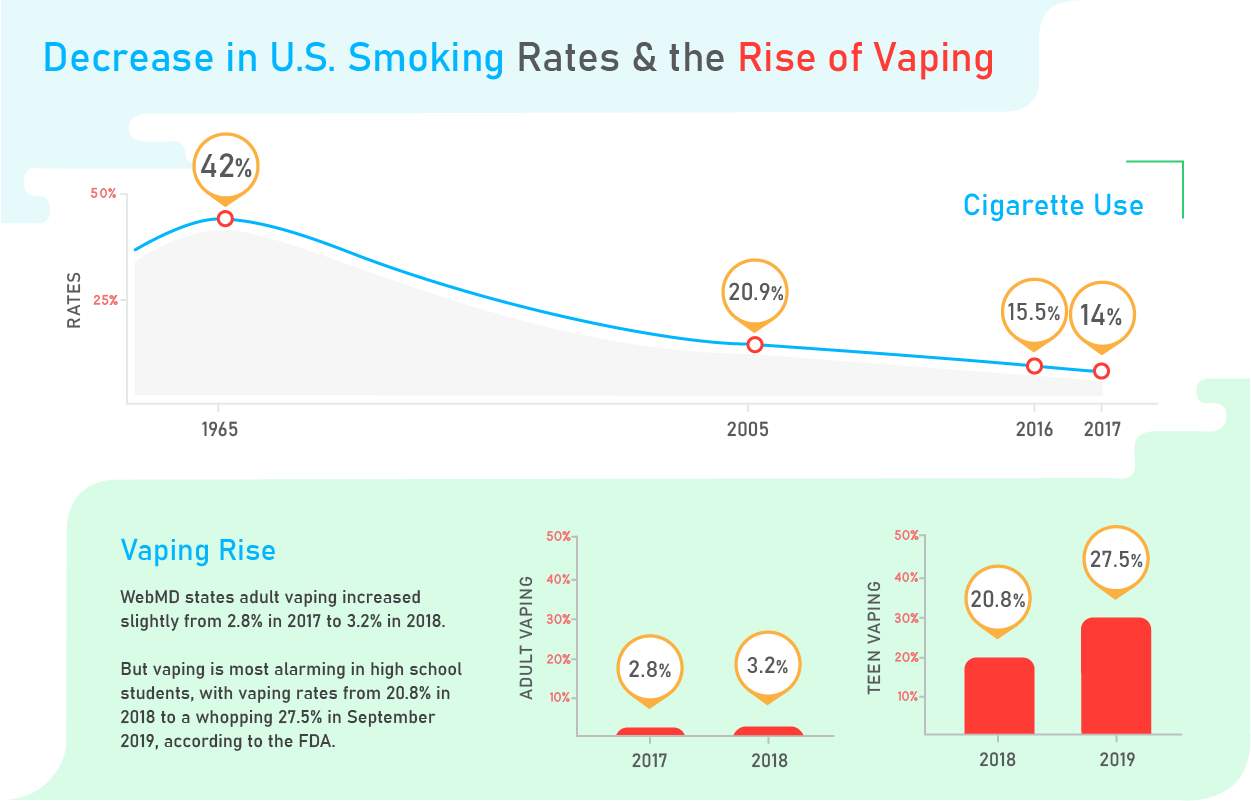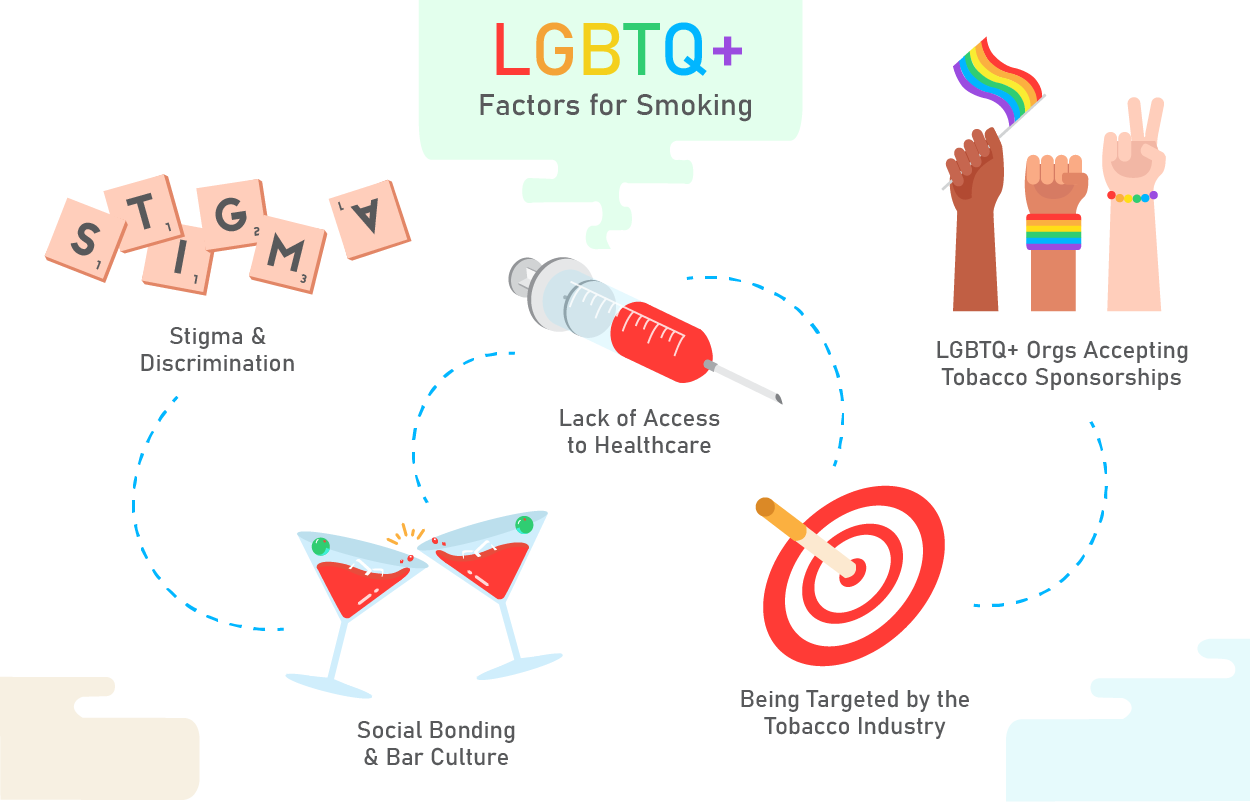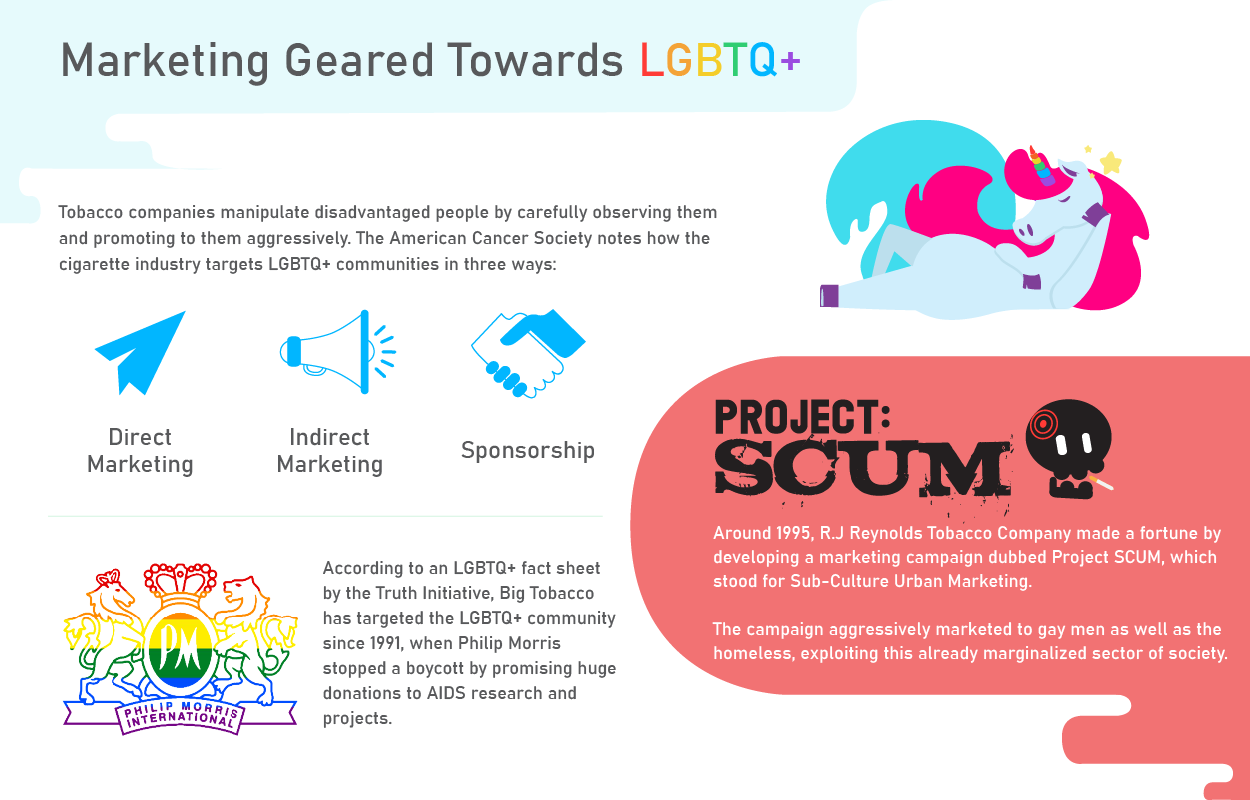- Home
- Health
- Vaping Risks
- LGBT
 LGBT Vaping Risks
LGBT Vaping Risks
How Tobacco and Vaping Companies Take Advantage of LGBTQ+ Communities
- Guide Authored by Corin B. Arenas, published on November 20, 2019
In our previous feature on vaping risks, an estimated 10.8 million Americans were using e-cigarettes in 2016.[1] A particular detail stood out: researchers found lesbians, gays, bisexuals and transgenders (LGBT) vaped more than the general population.
When it comes to cigarette use, SmokeFree.gov states that members of the LGBTQ+ community are about twice more likely to smoke than straight men and women.[2] Cigarette companies are aware of this, so they make sure these people stay hooked.
One is hard-pressed to know why LGBTQ+ groups are more prone to cigarette and vape use. Are these people really easily targeted by tobacco and vaping companies?
In this article, we’ll break down factors that make LGBTQ+ communities vulnerable to smoking and vaping. We’ll also talk about the marketing strategies employed by these industries to keep them addicted.
Please note that until more national and state tobacco surveys include information on sexual orientation and gender identity, public health researchers must depend on data collected by smaller localized studies. This means the data we gathered is limited and may only present lesbians, gays, bisexuals and transgenders.
Vaping and Smoking Statistics Among LGBT

In a 2016 study published in the Annals of Internal Medicine, researchers found that vaping was common among 7% of gays and lesbians compared to only 4.6% of heterosexuals.[3] E-cigarette prevalence was also around 9% among bisexuals and transgender people.
| Vaping Prevalence | Percent |
|---|---|
| Transgender People | 9% |
| Bisexuals | 9% |
| Gays | 7% |
| Lesbians | 7% |
| Heterosexuals | 4.6% |
So far, this research is the current reference we have on LGBT vaping. The rates would likely rise if a widespread survey of vaping is conducted among LGBTQ+ people throughout the U.S.
In relation to smoking, the Centers for Disease Control and Prevention (CDC) states that 20.5% of lesbians, gays and bisexuals smoked cigarettes compared to 15.3% of straight adults based on a 2016 National Health Survey.[4] The American Lung Association (ALA) also considers LGBTQ+ groups a priority population for tobacco control.
| Smoking Prevalence | Percent |
|---|---|
| Transgender people | 35.5% |
| Lesbian, gay and bisexual adults | 20.5% |
| Straight adults | 15.3% |
For transgender individuals, the CDC states there is limited data regarding their smoking habits. However, according to the National LGBT Cancer Network, transgender adults are reported to have extremely high rates of smoking which increases their risk of developing cancer.[5]
The Truth Initiative states that around 35.5% of transgender adults smoke cigarettes, which makes them 2.1 times more likely to smoke than straight adults.[6]
A study stretching from 1987 to 2000 found that LGBTQ+ youth smoke at a considerably higher rate than the general population.[7] Another research in the Journal of American Medicine Association (JAMA) found that lesbian and bisexual girls are around 9.7% more likely to smoke than heterosexual youth at only 2.5%.[8]
Decrease in U.S. Smoking Rates and the Rise of Vaping

Around 3% of the U.S. population identify as lesbian, gay or bisexual, states the CDC.[9] Since tobacco and vape use is highly prevalent in these groups, they inevitably affect the general trend of smoking and vaping rates.
The CDC also reported that cigarette smoking declined from 20.9% in 2005, to 14% in 2017, with an increased proportion of smokers who have quit.[10] This is the lowest U.S. health officials have seen, which is a dramatic improvement from the 42% smoking rate in 1965.[11]
| Year | Smoking Rate |
|---|---|
| 2017 | 14% |
| 2016 | 15.5% |
| 2005 | 20.9% |
| 1965 | 42% |
While the decrease spells good news, 1 out of 5 adults still use some form of tobacco. This includes vaping which defeats the purpose of anti-smoking initiatives, especially when people substitute smoking with nicotine-filled e-cigarettes. Furthermore, vapes contain potentially harmful ingredients that may cause lung injury and cancer.[12, 13]
According to WebMD, adult vaping modestly increased from 2.8% in 2017 to 3.2% in 2018.[14]
But the alarming increase is most apparent in high school students. Vaping rates boosted from 20.8% in 2018, to a whopping 27.5% as of September 2019, according to the Food and Drug Administration (FDA).[15]
| Vaping Rates Among Adults | Percent |
|---|---|
| 2018 | 3.2% |
| 2017 | 2.8% |
| Vaping Rates Among High School Students | Percent |
|---|---|
| 2019 | 27.5% |
| 2018 | 20.8% |
When it comes to cigarette use among the youth, the tables below shows how cigarette smoking declined between 2011 and 2019. Smoking rates decreased by 75% among high school students from 2011 to 2019, while it decreased by 67.6% among middle school students.
| Youth Cigarette Users | 2011 | 2019 | Decline Rate |
|---|---|---|---|
| High school students | 23.2% | 5.8% | 75% |
| Middle school students | 7.1% | 2.3% | 67.6% |
Data from the 2011 CDC youth tobacco research and the 2019 Youth Tobacco Survey [16, 17]
On the other hand, vaping rates significantly increased from 2011 to 2019 based on the 2019 National Youth Tobacco Survey.
The tables below show how e-cigarette use became more prevalent between 2011 and 2019. Vaping rates grew by 1,833% among high school students from 2011 to 2019, while it grew by 1,750% among middle school students.
| Youth Vape Users | 2011 | 2019 | Growth Rate |
|---|---|---|---|
| High school students | 1.5% | 27.5% | 1,833% |
| Middle school students | 0.6% | 10.5% | 1,750% |
As of November 2019, the FDA states that 5 million adolescents reported having vaped in the past 30 days, with almost 1 million reporting they vape daily.[18] While smoking cigarettes is at its lowest in the youth, increased e-cigarette use consequently defeats the purpose of tobacco control programs.
Though it is easy to presume the smoking decline is caused by vaping, there are health experts who don’t necessarily attribute smoking decrease to e-cigarettes.
In an interview with The Verge, CDC spokesperson Brian King from the Office on Smoking and Health thinks that if a majority of smokers were really switching to vapes, there should be a significant increase in vaping adults.[19]
Meanwhile, in the same article, Dr. Nancy Rigotti, director of the Tobacco Research and Treatment Center at Massachusetts General Hospital, states such view simply assumes people who switch to e-cigarettes continue vaping. The only way people can benefit from vaping as a smoking cessation tool is if they eventually quit.
Right now, there is no conclusive proof vaping can help entire populations stop smoking. The FDA does not approve e-cigarettes as an effective smoking cessation tool for the public.[20]
Nevertheless, the vaping industry is marketing e-cigarettes as a smoking alternative.[21] Knowing this, it’s unlikely companies would encourage hooked users to quit the habit.
Why are Smoking Rates so High Among LGBTQ+ Groups?
According to a cancer control booklet published by the American Cancer Society (ACS), there are several reasons why cigarette smoking has become a part of LGBTQ+ culture.[22]
In particular, it’s common for LGBTQ+ youth to feel out of place. A vast majority of smokers often start before the age of 21. In their need for acceptance, they are likely to smoke in order to ‘fit in.’
Smoking becomes part of their lifestyle and often continues as they age. The ACS also mentions LGBTQ+ meeting places are usually venues where people smoke, with cigarettes used as a conversation starter.
Smoking young gets people addicted early to nicotine, which makes the habit harder to break. It is also the leading cause of death in HIV-positive members of the LGBTQ+ community. HIV can shorten life up to 5 years, but smokers with HIV lose an average of 12 years off their life.[23]
Factors that Make LGBTQ+ Susceptible to Smoking

In a tobacco control document published by the American Lung Association (ALA), there are several contributing factors that make LGBTQ+ groups vulnerable to smoking.[24] While they encounter the same risks as the general population, LGBTQ+ individuals face additional risks such as:
Stigma and Discrimination
LGBTQ+ communities go through high levels of stress because of discrimination and marginalization from society in general. Stigma or being shamed by people causes this stress, especially rejection from family and friends.
How is this related to smoking? Research shows smoking prevalence as well as negative health behaviors are higher in groups with increased stress levels.[25] Another study in Nicotine and Tobacco Research surveyed why LGBT youth smoke.[26] The participants frequently cited the following reasons:
- Stress due to homelessness
- Coming out at an early age
- Rejection by family and peers
- Discrimination
Social Bonding and Bar Culture
Bars are historically one of the few spaces where LGBTQ+ people usually feel safe. Since these places are smoking venues which also encourage socializing, it plays an important role in getting LGBTQ+ people together. In some areas, they have fewer opportunities for interacting in non-smoking places.
Lack of Access to Quality Treatment and Healthcare
Research in the American Journal of Public Health notes that people in same-sex relationships are less likely to have health insurance than people in opposite sex relationships.[27]
Another study in the Journal of Epidemiology and Community Health showed that LGBTQ+ participants were twice more likely to report being refused or given substandard medical care compared to straight participants.[28]
Being Targeted by the Tobacco Industry
Aggressive marketing and promotion towards LGBTQ+ groups normalizes cigarette smoking. The ALA states that cigarette ads in gay and lesbian publications portray tobacco use as a typical part of LGBTQ+ life.
In a 2005 study, researchers found that around 30% of non-tobacco advertisements in LGBTQ+ publications featured tobacco use.[24] These non-tobacco ads included clothing, entertainment products and places, sexual services, as well as rehabilitation programs.
Acceptance of the Status Quo by LGBT Advocacy Organizations
Many leaders of LGBTQ+ organizations do not necessarily perceive tobacco control as an urgent health issue. In a 2008 study published in Culture, Health and Sexuality, researchers interviewed 74 LGBT leaders.[29]
Some of the leaders mentioned how smoking is considered central to the process of coming out. Though other heads acknowledged smoking is harmful to health, some of them stated that going against smoking could threaten tobacco sponsorships in their organizations.
Cigarette Marketing Tailored to LGBTQ+ Communities

Tobacco companies manipulate disadvantaged people by carefully observing them and promoting to them aggressively. The ACS notes how the cigarette industry targets LGBTQ+ communities in three ways: [22]
- Direct Advertising – Placing ads in magazines and other publications that cater to LGBTQ+ audiences
- Indirect Advertising – Placings ads with same-sex undertones in mainstream magazines with large gay and lesbian audiences
- Sponsorships – Giving money for LGBTQ+ event sponsorships (ex. Pride March), donating to LGBTQ+ orgs, and providing branded promotional products
The ads and sponsorships are directed toward important LGBTQ+ themes, some of which include individualism, acceptance, civil rights and social success. The ads project empowering messages, but the industry’s true motivation is to hook LGBTQ+ people into using harmful products.
According to an LGBTQ+ fact sheet by the Truth Initiative, Big Tobacco has targeted the LGBTQ+ community since 1991, when Philip Morris stopped a boycott by promising huge donations to AIDS research and projects.[30]
The boycott was headed by AIDS Coalition to Unleash Power, opposing the company’s support for Senator Jesse Helms—a harsh detractor of LGBTQ+ civil rights and AIDS funding. Under the guise of philanthropy, Philip Morris was able to tap the LGBTQ+ market, creating an opening for other cigarette companies to implement the same promotional techniques.
The early 90s saw the rise of cigarette ads in gay publications. Many ads also made cigarette smoking look glamorous, with articles featuring smoking even though the topics had nothing to do with cigarettes.
Sub-Culture Urban Marketing
Around 1995, R.J Reynolds Tobacco Company made a fortune by developing a marketing campaign dubbed Project SCUM, which stood for Sub-Culture Urban Marketing.[31]
The campaign aggressively marketed to gay men as well as the homeless, exploiting this already marginalized sector of society. Moreover, according to Harriet Washington, author of the research paper Burning Love: Big Tobacco Takes Aim at LGBT Youths:
“[T]obacco’s corporate language is sanitized in a Newspeak of acronyms and is bowdlerized to delete any overt reference to youth marketing.”
Apart from donations to the gay community, free products and increased ads, tobacco companies conducted community outreach efforts. Some of these outreach projects were hosted promotions for ‘LGBT bar nights,’ showcasing selected cigarette brands.[32]
The Promotional Strategies of the Vaping Industry
Through the years, vape companies have used many tactics to promote e-cigarettes. For adults, it’s usually being marketed as a smoking cessation aid, while different flavors appeal more to younger consumers. Vaping companies have also been seen sponsoring LGBT organizations during gay pride events.[33]
Targeting the Youth
In the U.S., JUUL is the leading e-cigarette brand in the market. Though it’s been successful over the last 5 years, its growth was punctuated by controversies.
For instance, in May 2019, the Wall Street Journal reported that the FDA accused JUUL for contributing to the rising rate of teen vaping, which likely includes underage LGBTQ+ vape users.[34] By November 2019, the FDA announced it will ban all flavored vapes to discourage e-cigarette use among the youth.[35]
Targeting Adults: From Smokers to Vapers
While vaping is not endorsed explicitly by physicians, there are doctors that say it is better than smoking.
In the U.K, the NHS states e-cigarettes are being supported by health experts as a smoking alternative.[36] This was after a study showed people who vape have lower levels of toxic chemicals in their body compared to tobacco users.
E-cigarette promotion is obviously targeted towards smokers, appealing to their desire to quit. It also makes sense for them to target LGBTQ+ communities, since this sector makes up a significant percentage of the cigarette market.
Do People Who Vape Actually Quit Vaping?
Rachel Grana, program director of the National Cancer Institute’s Tobacco Control Research, states there’s a major research gap as to whether people who vape can actually quit the habit.
According to the Wired, vapes usually contain nicotine, THC or both substances, and palatable e-juice flavors.[37] Their design can make vaping more addictive, rendering it more difficult to quit than cigarettes.
Essentially, quitting vapes is modeled after quitting cigarettes. But note that there are currently no tested or approved methods for vaping cessation.
There are, however, organizations like SmokeFree.gov that provide support to help people quit vaping. Moreover, the National Cancer Institute has a LiveHelp chat support service that allows you to talk to an expert about quitting.[38]
Vaping Might Encourage Simultaneous Use of Cigarettes
2015 data from the CDC states that 3.5% of American adults were using vapes.[39] Among this group, 58.8% were also smokers, while only 29.8% were former smokers and 11.4% had never used cigarettes.
| 2015 Study of Vape Users | Percent |
|---|---|
| Are also smokers | 58.8% |
| Former smokers | 29.8% |
| Had never smoked | 11.4% |
While it’s probable people who vape can quit smoking, this long-term research suggests that it might not be the case. People tend to continue smoking while using vapes, or worse, they might go back to smoking cigarettes completely.
There is no conclusive research that states vaping can cause cancer and other diseases associated with smoking. Though there have been reports on a vaping epidemic, there are people who still think vaping is safer than smoking cigarettes.[40, 41] However, vaping still has risks and people should eventually quit them too.
The Bottom Line
Both the vaping and cigarette industries target LGBTQ+ people, putting their health at risk.
LGBT groups are prone to cigarette and vape use as a way to cope with the stress of stigma and discrimination. They also associate smoking as part of their lifestyle, with many feeling comfortable in smoking venues like bars. These places are also instrumental in getting LGBTQ+ groups together.
Based on research, it’s evident tobacco companies have been taking advantage of LGBTQ+ people’s vulnerability to cigarette use. They promote aggressively to LGBTQ+ communities and even sponsor their organizations.
When it comes to vaping companies, like the cigarette industry, vaping is promoted to groups that are susceptible to smoking. It makes sense for them to market to LGBTQ+ people in the guise of quitting cigarettes. While they claim vapes are smoking cessation tools, there is no clear evidence it will help people quit smoking, or if vape users are likely to quit this ‘less risky’ habit.
About The Author
Working as a health writer since 2016, Corin is interested in longevity research and how to improve the quality of human life. She holds a Master’s degree in Creative Writing from the University of the Philippines, one of the top academic institutions in the world, and a Bachelor’s in Communication Arts from Miriam College. Her other feature articles can be read on Inquirer.net and Manileno.com.
References
- https://www.calculators.org/health/vaping-risks.php
- https://smokefree.gov/marketing-tobacco-lgbt-communities
- https://annals.org/aim/article-abstract/2698112/prevalence-distribution-e-cigarette-use-among-u-s-adults-behavioral
- https://www.cdc.gov/tobacco/disparities/lgbt/index.htm
- https://cancer-network.org/cancer-information/transgendergender-nonconforming-people-and-cancer/
- https://truthinitiative.org/research-resources/targeted-communities/tobacco-use-lgbt-communities
- https://www.ncbi.nlm.nih.gov/pubmed/11457635
- https://jamanetwork.com/journals/jamapediatrics/fullarticle/485675
- https://www.cdc.gov/tobacco/disparities/lgbt/index.htm
- https://www.cdc.gov/tobacco/data_statistics/fact_sheets/adult_data/cig_smoking/index.htm
- https://www.cdc.gov/media/releases/2018/p1108-cigarette-smoking-adults.html
- https://www.fda.gov/news-events/public-health-focus/lung-illnesses-associated-use-vaping-products
- https://www.cancer.org/cancer/cancer-causes/tobacco-and-cancer/e-cigarettes.html
- https://www.webmd.com/smoking-cessation/news/20191114/fewer-americans-than-ever-smoke-but-vaping-poses-a-growing-threat-cdc#2
- https://www.fda.gov/news-events/press-announcements/trump-administration-combating-epidemic-youth-e-cigarette-use-plan-clear-market-unauthorized-non
- https://www.ncbi.nlm.nih.gov/pubmed/22874835
- https://www.fda.gov/tobacco-products/youth-and-tobacco/youth-tobacco-use-results-national-youth-tobacco-survey
- https://www.theverge.com/2018/11/8/18075838/electronic-cigarettes-smoking-tobacco-vaping-juul
- https://www.fda.gov/consumers/consumer-updates/fact-or-fiction-what-know-about-smoking-cessation-and-medications
- https://www.nytimes.com/2019/09/09/health/vaping-juul-e-cigarettes-fda.html
- https://www.cancer.org/content/dam/cancer-org/cancer-control/en/booklets-flyers/tobacco-and-the-lgbt-communities.pdf
- https://www.ncbi.nlm.nih.gov/pubmed/23254417
- https://www.lung.org/assets/documents/tobacco/lgbt-issue-brief-update.pdf
- https://www.ncbi.nlm.nih.gov/pubmed/19117902
- https://www.ncbi.nlm.nih.gov/pubmed/17365728
- https://www.ncbi.nlm.nih.gov/pubmed/11684618
- https://escholarship.org/content/qt6j19835h/qt6j19835h.pdf
- https://www.ncbi.nlm.nih.gov/pmc/articles/PMC2789682/
- https://www.truthinitiative.org/sites/default/files/media/files/2019/03/Truth_LGBT%20FactSheet_FINAL.pdf
- https://www.ncbi.nlm.nih.gov/pmc/articles/PMC3222279/
- https://www.ncbi.nlm.nih.gov/pubmed/15231106
- https://www.vaporfi.com/blog/vaporfi-is-proud-to-be-a-sponsor-at-the-2014-miami-beach-gay-pride-festival/
- https://www.wsj.com/articles/walmart-to-raise-tobacco-age-to-21-drop-fruit-flavored-e-cigarettes-11557330870
- https://www.wsj.com/articles/fda-expected-to-ban-all-e-cigarette-flavors-except-tobacco-and-menthol-11572969360?tesla=y
- https://www.nhs.uk/news/heart-and-lungs/long-term-vaping-far-safer-than-smoking-says-landmark-study/%5d
- https://www.wired.com/story/so-you-want-to-quit-vaping-no-one-actually-knows-how/
- https://livehelp.cancer.gov/app/chat/chat_launch
- https://www.cdc.gov/mmwr/volumes/65/wr/mm6542a7.htm
- https://www.cdc.gov/tobacco/disparities/lgbt/index.htm
- https://surveys.google.com/reporting/question?hl=en-US&survey=ymx65f3ltrvunt3ou53lmk6qwu
